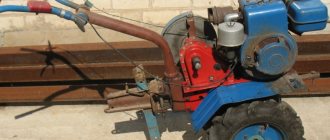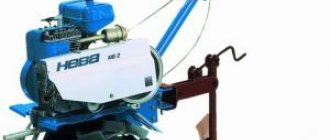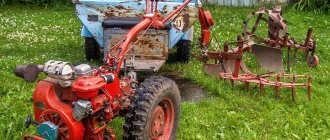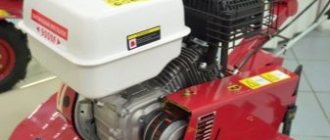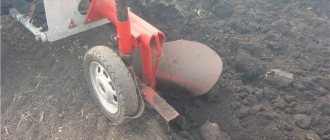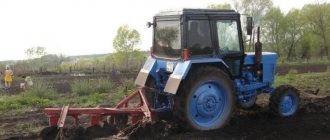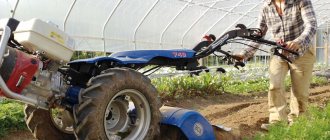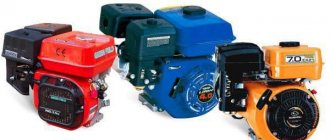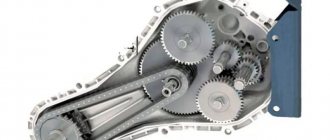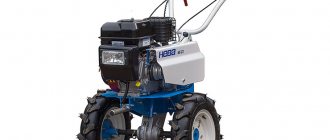Plow diagram. Diagrams of different plows and their purposes
A standard plow is capable of plowing the ground to a depth of 18-35 cm. There is a smooth method of plowing with plowshare plows, but for better cutting and crushing of the layer, right-hand repellent bodies can be attached to the plow, forming a dump-type plowing.
Then, at the slightest deviation to the side from the given direction, the blade crushes the earth into small pieces. A standard plow (plow diagram) consists of a frame, a knife, a skimmer, a coupling mechanism with a tractor, and a body. The plow may have support wheels. There may be several of them, or one. Depends on the design of a particular plow. The body, in turn, is a combination of a ploughshare, a blade and a field wheel. You can see a diagram of a standard plow below:
So here is a complete diagram of the plow:
- - skimmer,
- - plow body,
- - frame,
- - plow knife,
- - support wheel,
- - support wheel adjustment screw,
- — tractor clutch mechanism.
Let us determine the principle of coupling a plow to a tractor. Based on this criterion, mounted, semi-mounted and trailed plows can be classified.
Plows based on the hitch principle
Mounted plows are characterized by the fact that the plow is attached to the tractor by attaching the plow's hinged mechanism to the same mechanism on the tractor.
Trailed plows are attached to the tractor through a trailed eyelet.
The automatic coupling of the plow with the tractor is formed due to the operation of the lock and frame. The lock is securely fastened, and the frame is fixed with a finger to the lower arms of the tractor canopy, and with a cheek to the upper link.
Attaching the plow to the tractor
During operation, both the frame and the lock are supported by a pawl, which is connected to the driver’s cabin through a cable. This way the tractor driver can release the clutch directly from the cab. The hitch includes two counter posts and a brace. They are connected to each other with one bolt.
The posts are attached to the brackets. The brackets are attached to the plow frame with bolts. Trailed plows are characterized by the presence of three wheels in their design.
1. Furrow wheel - front, placed closer to the front body at a distance of 3-4 cm from the wall of the furrow. In this case, the wheel should not interfere with soil rejection.
2. The field wheel is the second wheel, it follows the furrow wheel. The rear one is the very last one. Each wheel accounts for about 30% of the total plow weight. Semi-mounted plows have two wheels. This is a field wheel and a furrow wheel, which is located at the rear.
Plow attachment diagram
- - lock,
- - brace,
- - plow handle,
- - neck,
- - finger,
- - frame,
- - fastening pawl,
- - finger,
- - plow stand,
- - bolt,
- - plow brace,
- - bracket
Three-tier plow
So, let's talk about three-tier plows. They are the most popular among the people, since if desired, a three-tier plow can be easily adapted for two-tier plowing. When we want to leave the top layer of the soil we have processed on top, and mix the second and third layers together, we need to remove the rear body, install an extended blade on the front one, and place the middle body on the main beam behind the first body.
When the top layer of soil is littered, we transfer it to the bottom of the furrow: we put the front body with a cultural dump instead of the rear one, and we put the middle body in place of the outrigger beam. Below you can see a diagram of a three-furrow plow. For you, as an option, the diagram of the PTN 40 plow is shown below:
diagram of the plow PTN 40
- - front body,
- - main middle body,
- - rear body,
- - frame beam (main),
- - beam for harrows,
- - pendant,
- - support wheel,
- - outrigger beam,
- - cutting knife,
- - suspension pin
Diagram of a plow with a hydropneumatic fuse
Previously, we looked at standard plows for cultivating soft soil. The plow for cultivating rocky soil is equipped with a hydropneumatic safety device.
- - hydraulic cylinder,
- - oil line,
- - pressure gauge,
- - hydropneumatic accumulator,
- - gas chamber,
- - fuse piston,
- - valve, 8 - check valve,
- - plow frame,
- - plow support wheel,
- - plow body
This increased resistance to difficult-to-arable soils is explained by the active interaction of the plow's hydropneumatic accumulator with the tractor's hydraulic system.
When the plow hits a rock, the plow body rises, moving the cylinder plunger, and the cylinder, as it moves, pushes oil into the battery, supplying it with energy. Then the body returns to its normal state, and its beam rests against the frame again.
Important Combine harvester SK-6 Kolos: review, technical characteristics, owner reviews
Horse plow diagram
Also, for light soils, the technical bells and whistles of a horse-drawn plow are suitable. You are shown a plow of the PV-23 brand. This is a hanging plow, which means it only has one insignificant support wheel. It practically does not rest on it, so the operator needs to support it with his hands.
- - cutting knife,
- - ploughshare,
- - dump,
- - field board,
- - handle
- - rowdy,
- - plowing depth regulator,
- - coverage width adjuster,
- - harness hook,
- - wheel and supporting stand of the plow.
How much does it cost to plow a field?
Manual cultivation of the soil is a rather difficult task, and if it is also virgin soil, then almost impossible. Therefore, farmers and summer residents, in order not to work manually, try to acquire special agricultural equipment - cultivators, motor cultivators, walk-behind tractors, mini tractors and various accessories for them. The equipment will allow high-quality plowing of virgin soil and quickly cultivating plowed lands.
But not every owner of a farm or dacha land has the opportunity to purchase a whole arsenal of motorized equipment. Often the power of a purchased cultivator is simply not enough to cultivate virgin soil or plow an abandoned garden. In this case, you have to turn to the owners of more “serious” agricultural equipment for help - powerful mini tractors and tractors. These high-performance machines become especially popular during the pre-planting and post-harvest seasons. They quickly and efficiently process the field, cultivate, cultivate overgrown turf and virgin soil.
Of course, agricultural machinery services are not cheap. The cost of mechanized work performed by a tractor depends on various factors, in particular:
- prices for fuel and lubricants;
- dimensions of the treated area;
- the degree of neglect of the site, the presence of vegetation on it;
- relief and condition of the soil that will be processed;
- distances from the place where the equipment is parked to the place where it will work;
- the type of excavation work and the agricultural implements used to carry it out.
How much it costs to hire a tractor for plowing virgin soil or cultivating plowed land can be found out on thematic forums where experienced farmers and beginners exchange relevant information with each other and give practical advice. Typically, tractor owners calculate the cost of plowing as follows: all costs of processing + 45-50% (virgin soil, naturally, is more expensive). But it’s difficult to say exactly the final amount, since prices can vary greatly in different regions of the country.
The most expensive tractor work is considered to be plowing virgin and arable land using a disc harrow, a tillage cutter and a three-furrow plow (25,000 rubles/1-5 hectares). It will cost a little less to disk the earth and mow the grass if you work with a mini tractor using a mounted rotary mower and a tooth harrow (20,000 rubles/1-5 ha). But even at relatively high prices, the services of tractors and mini-tractors are used by many farmers, including owners of garden and country plots. Whatever one may say, plowing and cultivating without equipment is difficult and time-consuming. In addition, this is a very responsible process that cannot be done without time and financial investments.
Motoblocks Neva
Recommendations
The first and very important rule is to follow safety precautions. Select the size of wheels with lugs wisely. There is no need to chase the diameter, otherwise the linear speed will be excessively high. The ideal diameter is 460-500 millimeters. The dimensions of the plow depend on the weight of the tractor; this indicator must also be taken into account
For motorized equipment weighing approximately 100 kilograms, the largest plows are installed, with a grip of 23 centimeters. For units weighing up to 75 kilograms, plows with a grip of 18 centimeters are best suited. A plow with a grip of 13 centimeters is suitable for lighter units.
Here, too, from time to time they make a mistake - they purchase a relatively light unit and install a large plow on it. If you also try to use such a “duet” on rough ground, the effect will be completely predictable – “it doesn’t plow up.” But the point is not in the quality characteristics of the plow, but in its incorrect selection and/or adjustment. In general, the design of the unit is simple and understandable. But under any conditions, like any other equipment, it requires care, timely maintenance and replacement of consumables. Use only high quality spare parts recommended by the manufacturers.
To learn how to properly adjust a plow on a walk-behind tractor, watch the following video.
User manual
The walk-behind tractor includes not only the engine, but also the gearbox, cutting discs and bearings. All of these parts require timely maintenance and attention from the user. Bearings operate below the surface of the soil, which leads to premature failure as dirt gets into the housing. Proper maintenance requires lubricating and cleaning the element regularly.
The teeth or blades must be sharp; this is the only way to guarantee high-quality tillage. The engine in the design drives not only the cutter, but also the gear, which is responsible for the direction of movement, including reverse.
How to prepare for work?
Work on a walk-behind tractor will be of high quality only if the user properly prepares the equipment and monitors it. Before turning on the ignition, you must check the unit and put on appropriate clothing.
How to install correctly?
First you need to put on the earring. It will be necessary to attach the working part to it. Attach it using cotter pins and bushings
Important: fasteners should be inserted into the second hole from the bottom. This allows you to adjust the depth of the cutters in an optimal way for complete cultivation of the land.
It happens that the standard depth (20 cm) is not enough. To set the opener to go deeper, it is lowered and attached to the shank through the upper holes. On the contrary, if it is necessary to process only the top layer of soil, before using the tool it is attached through the lower hole. Experts recommend initially organizing a test run of the walk-behind tractor. Only he will show whether everything was done correctly.
How to plow with a walk-behind tractor and plow
If you have a standard plot of 6 acres of land at your disposal, then it is better to walk it with a walk-behind tractor from the light series. It weighs little and is easy to operate. Such a motor cultivator will cope with the site very quickly. It is customary to use cultivators and cutters as attachments for small areas. The processing technology is as follows: the mini-machine is installed at the edge of the site, starts up and moves forward at maximum speed, turning at the corners of the site. So, gradually the walk-behind tractor moves towards the center.
For large areas it is advisable to use medium and heavy cultivators. In this case, you simply cannot do without a plow:
- Control plowing is performed in two directions.
- During plowing, the position of the plow relative to the ground and the quality of the furrow are assessed.
- If there are no questions, they proceed to complete the full scope of work.
- The speed of the walk-behind tractor is increased, the furrows and the dump of the earth are smooth and neat.
Important How to assemble a Mishutka tracked all-terrain vehicle
This is interesting: installing a plow on a Neva walk-behind tractor.
This method is suitable for all types of soil. If work is carried out on hard and rocky soil, it is better to process it in two passes at different depths. At the second stage, in order to prevent the soil from sliding, waves can be made across the previous ones. When passing longitudinally, it is recommended to lay the wave between two old ones so that there is not a large distance between them.
When carrying out work related to plowing the land, it is necessary to adhere to certain instructions and rules:
- To begin with, control plowing is performed and the resulting furrow is analyzed.
- They adjust the plow, the quality of the moldboard and the depth of the strip.
- The furrow ridges should be at an equal distance from each other.
- The possibility of superimposing a new soil dump on the old one is excluded.
Knowledge about setting up a plow on a walk-behind tractor allows you not only to set up the equipment correctly, but also to perform high-quality plowing in the shortest possible time. Impeccable adjustment is the key to preparatory work on a personal plot.
Typical mistakes when choosing a walk-behind tractor
Many inexperienced farmers, when buying a walk-behind tractor for cultivating the soil on their plot, thoughtlessly focus only on cost and appearance. This approach can lead to breakdown of the agricultural unit or inconvenience during its use. Let's look at the main mistakes when buying a walk-behind tractor, and tips that will help you make the right choice.
- When the future owner of motorized equipment for cultivating the land is not aware of the size of his plot and the types of soil on it. For example, for a summer cottage plot of 6 acres, a light-class walk-behind tractor will be sufficient. Even if there is virgin soil on it, you can hire a tractor for plowing once rather than buy a heavy unit and experience inconvenience when using it in the future on a plot with a small area.
- When the farmer does not know exactly what attachment he will use. It is necessary to think in advance which tools will be needed first, and not try to choose a walk-behind tractor with the maximum number of attachments, which may not be useful later. Read specialized forums or watch video reviews of experienced users to compile a list of attachments, taking into account the manufacturer’s recommendations.
- You should select in advance a walk-behind tractor model from a trusted manufacturer, the build quality of which will not be in doubt. This is where reviews and testimonials about equipment will come to the rescue; you should not rely only on the consultant in the store. If you primarily focus on cost when purchasing, then when using a cheap unit the following disadvantages will appear:
- poor quality of metal and plastic;
- greatly inflated technical characteristics;
- short engine life;
- difficulty in assembling the walk-behind tractor;
- inconvenience and discomfort during operation: increased noise and vibration levels, heavy weight, non-ergonomic handle without the option of turning and adjusting.
Application
Depending on the model and equipment with additional attachments, Neva MB2 walk-behind tractors are used for:
- plowing the soil;
- loosening;
- soil cultivation;
- furrowing the soil before planting;
- hilling;
- digging up potatoes;
- clearing weeds and snow.
The Neva MB2 walk-behind tractor is considered a classic for domestic buyers.
Run-in
Running in the engine is an important stage in the operation of the unit, which must be carried out after a long period of inactivity or after purchasing equipment. Reliable operation of the Neva MB2 walk-behind tractor directly depends on proper running-in. Such a test is necessary to extend the life of the walk-behind tractor. Before running in, you should check all connections and ensure that all parts are in good working order.
Cultivation
Due to their versatility, the Neva MB2 walk-behind tractors can also be used as a cultivator.
Thanks to this unit, you can perform several types of complex excavation work:
- Plow the ground overgrown with grass. This means that the Neva MB2 walk-behind tractor is perfect for cultivating a plot of land whose territory is overgrown with weeds and grass. If the weeds are overgrown with thick grass, the grass will need to be mowed before cultivation.
- Plowing a constantly cultivated plot of land. In this case, the soil is first fertilized, and then, with the help of a cultivator, furrows are formed for planting the crop.
- Digging up the culture. A potato digger is great for digging up root vegetables. During operation of the walk-behind tractor, the length of the digging stand is adjusted, and in order not to damage the potato tubers, they are dug out through the row.
Several types of complex excavation work can be performed thanks to this unit.
How to start a Neva walk-behind tractor - Technology Expert
If you have been using the Neva , then there is no point in this article to figure out how to start tractor , but let’s touch on the moment that happens to everyone at one not-so-wonderful moment: the sun is shining, it’s time to plow, but the walk-behind tractor won’t start!
Let’s make a reservation right away that this article will not make you a walk-behind tractor repairman, but will simply make you understand where to find the fault and roughly evaluate the nature and methods of repairing a walk-behind tractor. We would also like to note that you can always contact our service center, where experienced specialists will provide professional assistance and carry out high-quality repairs of the Neva !
Repair of the Neva begins with troubleshooting; first you need to find out what exactly is not working: the engine or the gearbox. If during operation the walk-behind tractor suddenly stops, you should release the clutch lever, turn off the gear and look for the malfunction in the following order:
- If the walk-behind tractor does not start, then it is logical to look for a fault in the engine. First, determine whether the engine is turned by the starter cable. If the engine runs very lightly, the engine turns over effortlessly, then the fault is in the mechanical part of the engine: either the valve group, which is responsible for closing and opening the valves, also includes the pushrod, or a broken connecting rod is to blame. This conclusion can be drawn if, during engine diagnostics, when you crank the starter, you hear extraneous metallic knocks. This repair is quite complicated, so it is advisable to bring the walk-behind tractor engine to a service center, where experienced mechanics will determine the malfunction and name the exact cost of repairing the walk-behind tractor and spare parts for it.
- If the engine does not turn over with the starter, you can judge that the connecting rod-piston group is jammed; in this case, the walk-behind tractor is repaired by overhauling the engine. Our mechanics will do the engine overhaul efficiently and in a very short time. Attention! There is a rare, but very absurd exception to this malfunction: when transporting a walk-behind tractor on its side, the oil that fills the crankcase flows into the combustion chamber (this is a design feature of a four-stroke engine, and the oil is not compressible), so when diagnosing a walk-behind tractor, you need to unscrew the spark plug and try crank the engine again. Perhaps you will be lucky and this will not be a malfunction, but just a misunderstanding.
READ How to Make a Snowmobile From a Motoblock Video
The next stage of repair of the Neva : the engine cranks with normal effort, there is compression, but there are no flashes in the cylinder. Determine whether the fuel mixture is flowing: remove the spark plug, it should be wet. If this is not the case, then there is a malfunction in the fuel system of the walk-behind tractor.
Motoblock Neva MB-2 review, starting
Repairing the fuel system involves checking the flow of fuel from the gas tank through the gas tap into the carburetor. If fuel flows, carburetor repair is necessary.
Agree that it is better to repair the carburetor of a walk-behind tractor in a specialized service center, and not in a garden plot.
The spark plug turned out to be wet, which means fuel is entering the cylinder and then there is a problem with starting the walk-behind tractor in the absence of a spark. First, try to replace the spark plug; maybe an insulation breakdown has caused it to fail.
the main malfunctions of the Neva and now let's turn to the next stage of walk-behind tractor malfunctions: the engine is running, but the walk-behind tractor does not move.
- First, check the clutch belt - it often happens that such a belt fails, because torque is transmitted through it from the engine to the gearbox.
- Now about repairing the gearbox of the Neva : the belt has been checked and it transmits rotation. This means the malfunction is much more complex than we would like.
Motor DM-2
To operate the walk-behind tractor, according to the instructions, use pure unleaded gasoline of the A-92 brand. If you use a clean canister for intermediate storage, and be sure to settle the fuel before starting operation, and do not fill the last 100-150 ml into the tank, but carefully drain it for other purposes, then there should be no problems with the operation of the engine.
The most painful part of a walk-behind tractor engine is its carburetor. Not only is it almost impossible to adjust the operation according to the instructions, but even at the factory settings the needle does not lock and regularly pours fuel into the intake tract. Accordingly, after 20-30 hours the engine oil in the crankcase turns into a stinking slurry.
According to the instructions, M10GI mineral oils are used to fill the engine crankcase; in practice, semi-synthetics and synthetics are used, for example, 10W40 approximately 1.3 liters. For the gearbox, the instructions require filling 2.2 liters.
Advice! If it is not possible to adjust the needle hang and gasoline regularly gets into the crankcase, then it is better to buy inexpensive mineral water and change it every 50 hours of driving.
To start the engine according to the instructions, you need:
- Open the tap, pump fuel into the carburetor and move the pump foot to the starting position;
- Hole a couple of times with the damper open;
- Close the throttle completely and start the engine.
Of course, when the walk-behind tractor engine is hot, it is started with the throttle open.
Is it necessary to drain gasoline from a walk-behind tractor for the winter?
The operating instructions clearly state that the fuel must be drained from the walk-behind tractor before winter storage. But owners have differing opinions on this matter. Some say that it is best to drain the gasoline and let the tank dry thoroughly. Others advise filling the tank to the top to prevent corrosion.
There will be no corrosion of the tank either in the first or in the second case. But following fire safety precautions, there is no need to leave the walk-behind tractor with a full tank of gasoline. Also, gasoline may become waterlogged during inactivity.
Our advice is that before winter storage, be sure to drain the gasoline, exhaust any remaining fuel in the system, and let the tank dry. After such actions, there will be no problems with the fuel system of the walk-behind tractor in the spring.
READ How to turn on a Bosch stove
Choice
To perform such work, the correct choice of plow is important. This tool can be of several types:. The single-body plow has the simplest design, clear fasteners and small dimensions
Excellent for standard excavation work
The single-body plow has the simplest design, clear fasteners and small dimensions. It is excellent for standard excavation work.
The reverse tool is distinguished by the presence of a bend in the upper part of the feather, which helps to turn over layers of earth. This design is intended for processing heavy types of soil.
The rotary plow has the most complex structure. It has several ploughshares, and depending on this, it can be two- or three-body. Its distinctive feature is its low operating speed (compared to cutters) and small processing depth. This tool is well suited for loosening already developed land.
The disc plow is used for wet or very wet soil. But its processing depth is the smallest of all types.
After choosing the type of plow you need, you need to pay attention to a few more details. First of all, this is the type of fastening
It must fit the motor cultivator. Next, it’s worth checking with the seller whether the existing machine has enough power to work with this type of attachment. If the unit has low power, then there is a risk of significant wear or complete overheating of the cultivator engine over a short period of operation.
For information on how to plow correctly using a mounted plow, see below.
Important Review of the characteristics of the Centaur mini tractor model range
What attachments does the walk-behind tractor work with?
Any experienced farmer knows that with the help of a walk-behind tractor, cultivator or other motorized equipment, almost all agricultural work can be mechanized, from cultivating the land to prepare it for sowing and ending with transporting the harvested crop. Motor units have become universal due to the possibility of using a variety of attachments. For example, for cultivating plowed land and cultivating virgin lands, not only moldboard and other plows were created, but also:
- harrows;
- hillers;
- rotary cutters;
- flat cutters-weeders.
Harrows are used to plow virgin soil, as well as for pre-sowing or post-harvest loosening of arable soil to a depth of 7-14 cm. Using harrowing with a walk-behind tractor or cultivator, the surface is leveled, moisture is covered, and weeds are destroyed. The working parts of such agricultural implements are metal teeth or spherical disks. In this video you can clearly see how to properly plow with a walk-behind tractor and a homemade harrow.
How to adjust correctly?
Plowing depth is the distance to which the plow plunges into the soil during operation. It must be adjusted as far as the bayonet of the shovel can reach. Otherwise, the following problems may occur.
- If the depth is insufficient, a considerable proportion of the roots of weeds will remain under the ground, which will require new efforts to eliminate them.
- If the depth is greater than required, the fertile soil layer will mix with what is located underneath it, and the vegetation will not have adequate nutrition. In this regard, you need to stick to the golden mean.
Attack angle
For someone who already has the practical skill of plowing soil with motorized equipment, there is no need to explain what and how to do at this stage. The following information is provided for informational purposes to those who are encountering this matter for the first time. The slope of the angle of attack, or, as it is also called, the slope of the angle of the field board, is a slope that shows the height of the plowing plane in relation to a flat plane. Adjustment is carried out using a screw knob.
The order of operations is as follows:
- place the unit with the plow on the supports mentioned earlier;
- turn the adjustment knob to the limit so that the field board rests completely on the ground, without gaps;
- start turning the handle in the opposite direction until the back of the board rises 2-3 cm above the ground.
If you make a miscalculation, the following unpleasant consequences will appear:
- with a large angle of the field board, the plow will become an anchor - the unit will begin to regularly slip and move forward with effort;
- at a small angle, the required layer of soil will not be removed.
- You can check whether everything is correct only at the plowing stage - the unit should not resist or move excessively freely.
Preparation for plowing
Before plowing, you need to perform a test plowing and find out the quality of the plow adjustment.
To do this you need:
- find out the features of the blade and the depth of the furrow;
- control the movement of the plow in the furrow;
- monitor the regular movement of the unit and the load on the plowman’s hands;
- set the load of the unit.
Test plowing of the site is performed as follows.
We place the unit on the edge of the cultivated plot of land. We set the first speed and carefully press the clutch handle. It is extremely important that the steering wheel of the unit is parallel to the plane of the ground, so that the unit does not dig into the ground, but also does not rise above the arable land being cut. When plowing, the worker does not need to press the steering wheel or push the motorcycle too diligently, since this agricultural machine itself will perfectly cope with its responsibilities without auxiliary efforts. After obtaining a test furrow, you must definitely measure the depth of plowing. To do this, you need to use a tape measure or an ordinary ruler
If the dimensions match those initially established, then you can begin the main work.
Installing a plow on a walk-behind tractor
The design of any plow, regardless of its size and shape, contains a hitch through which the device is attached to the walk-behind tractor. The hitch can be stationary or universal. The second type of element is considered the most optimal option, since it provides more opportunities for adjusting the plow.
Regardless of the type of hitch, installation of the structure on the walk-behind tractor is always performed in the same order. To attach a plow to a walk-behind tractor, proceed in the following sequence:
- First, install the walk-behind tractor on stands - you can use bricks or logs for this;
- Attach the plow hitch to the towbar of the walk-behind tractor so that the holes on both elements coincide with each other;
- Secure the hitch to the tow bar with bolts.
Many beginners believe that the more securely the plow is attached to the walk-behind tractor, the more efficient the work of the attachment will be. However, practice shows that too rigid a connection will only worsen the quality of plowing. The fact is that when operating a plow, forces act on it that go perpendicular to the plane of the blade. Because of this, resistance arises, which pushes the plow away from the walk-behind tractor. To eliminate this, when installing the plow, you need to leave a horizontal play of about 5 degrees.
